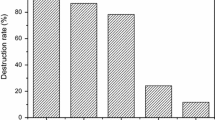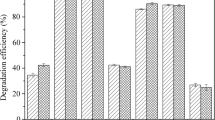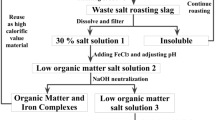Abstract
Polyvinyl chloride (PVC) was milled with hydrated or unhydrated calcium sulfates (CaSO4·2H2O or CaSO4) in air by using a planetary mill to investigate mechanochemical dechlorination behavior. The milling process resulted in size reduction and in the breaking of bonds leading to mechanically induced solid state reaction, forming CaCl2 and dechlorinated hydrocarbon with C=C double bonds in the product. Washing the milled mixtures with water at room temperature allowed removal of the chloride formed during milling, and more than 95% of the chlorine in PVC was removed from a mixture milled for 4 h. This process could offer a potential route for the handling and disposal of both PVC and gypsum wastes. H2S gas was generated during milling; more H2S was released from the unhydrated sample than from the hydrated sample.
Similar content being viewed by others
References
Zhang Q, Saito F, Shimme K, Masuda S (1999) Dechlorination of PVC by a mechanochemical treatment. J Soc Powder Technol Jpn 36:468–473
Saeki S, Kano J, Saito F, Shimme K, Masuda S, Inoue T (2001) Effect of additives on dechlorination of PVC by mechanochemical treatment. J Mater Cycles Waste Manag 3:20–23
Inoue T, Miyazaki M, Kamitani M, Kano J, Saito F (2004) Mechanochemical dechlorination of polyvinyl chloride by co-grinding with various metal oxides. Adv Powder Technol 15:215–225
Inoue T, Miyazaki M, Kamitani M, Kano J, Saito F (2005) Dechlorination of PVC by its grinding with KOH and NaOH. Adv Powder Technol 16:27–34
Tongamp W, Kano J, Zhang Q, Saito F (2006) Mechanochemical decomposition of PVC by using La2O3 as additive. J Hazard Mater B137:1226–1230
Tongamp W, Kano J, Zhang Q, Saito F (2008) Simultaneous treatment of PVC and oyster-shell wastes by mechanochemical means. Waste Manag 28:484–488
Ikoma T, Zhang Q, Saito F, Akiyama K, Kubota ST (2001) Radicals in mechanochemical dechlorination of hazardous organochlorine compounds using CaO nanoparticles. Bull Chem Soc Jpn 74: 2303–2309
Zhang Q, Saito F, Ikoma T, Kubota ST (2001) Effects of quartz addition on the mechanochemical dechlorination of chlorobiphenyl by using CaO. Environ Sci Technol 35:4933–4935
Tanaka Y, Zhang Q, Saito F, Ikoma T, Kubota ST (2005) Dependence of mechanochemically induced decomposition of monochlorobiphenyl on the occurrence of radicals. Chemosphere 60:939–943
Author information
Authors and Affiliations
Corresponding author
Rights and permissions
About this article
Cite this article
Tongamp, W., Kano, J., Zhang, Q. et al. Mechanochemical dechlorination of polyvinyl chloride with calcium sulfates. J Mater Cycles Waste Manag 10, 140–143 (2008). https://doi.org/10.1007/s10163-007-0199-4
Received:
Accepted:
Published:
Issue Date:
DOI: https://doi.org/10.1007/s10163-007-0199-4




